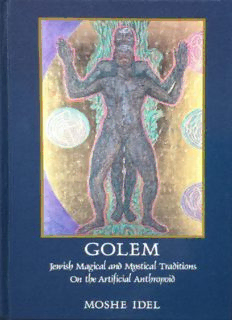
Golem: Jewish Magical and Mystical Traditions on the Artificial Anthropoid PDF
Preview Golem: Jewish Magical and Mystical Traditions on the Artificial Anthropoid
Golem Front Cover Photo: Golem Couple SUNY Series in Judaica: Hermeneutics, Mysticism, and Religion Michael Fishbane, Robert Goldenberg, and Arthur Green, Editors Golem Jewish Magical and Mystical Traditions on the Artificial Anthropoid Moshe Idel State University of New York Press Paintings on cover and in text by Abraham Pincas. Published by State University of New York Press, Albany © 1990 State University of New York All rights reserved Printed in the United States of America No part of this book may be used or reproduced in any manner whatsoever without written permission except in the case of brief quotations embodied in critical articles and reviews. For information, address State University of New York Press, State University Plaza, Albany, N.Y., 12246 Library of Congress Cataloging-in-Publication Data I del, Moshe, 1947- Golem : Jewish magical and mystical traditions on the artificial anthropoid / Moshe Idel. p. cm.—(SUNY series in Judaica) Bibliography: p. Includes index. ISBN 0-7914-0160-X. — ISBN 0-7914-0161-8 (pbk.) 1. Golem. 2. Mysticism—Judaism —History. I. Title. II. Series. BM531.134 1989 89-30042 296.1'9 -de 19 CIP 10 9 8 7 6 5 4 3 2 1 To Abraham, who created Golems Contents Acknowledgments ix Abbreviations xi Introduction XV Part One Ancient Traditions 1. Ancient Parallels 3 2. Sefer Yezirah 9 3. Talmud and Midrash 27 Part Two Medieval Elaborations 4. Tempering Magic: Geonic and Rationalistic Attitudes 47 5. Ashkenazi Hasidic Views on the Golem 54 6. The Northern France Discussions 81 7. The Golem in Ecstatic Kabbalah 96 8. R. Joseph ben Shalom Ashkenazi 119 9. Psychological Implications of the Golem 127 10. Theosophical Interpretations of the Golem 134 viii Contents Part Three Renaissance Period 11. Sixteenth and Seventeenth Century Discussions in the West 165 12. R. Moses ben Jacob Cordovero's View 196 Part Four Early-Modern and Modern Reverberations 13. R. Eliyahu, the Master of the Name, of Helm 207 14. Golem in the Halakhah 213 15. Golem and Sex 232 16. Vicissitudes of the Golem Techniques 242 17. Golem and Hasidic Mysticism 247 18. Modern Reverberations 251 19. Golem: Imaginaire, Anomian, and Silent 259 20. Summary 269 Part Five Appendixes A. Golem and Zelem 285 B. Golem: Some Semantic Remarks 296 C. Was There a Macranthropos Named 'Emet? 306 Subject Index 315 Author Index 319 Acknowledgments My interest in the topic of the Golem commenced in 1975, when I was preparing my Ph. D. on the Kabbalah of Abraham Abulafia. His original treatment of this theme aroused my curiosity and despite the fact that I devoted to this issue only a few pages in the thesis, I continued for years to collect related material from manuscripts. My return to this issue in a more concrete manner was catalyzed by an invitation from the Jewish Museum to contribute an essay to the catalogue of an exhibition on the Golem in 1988, organized by Mrs. Emily Bilski. The essay in that cata- logue treated a few new texts and exposed briefly new ideas concerning the concepts of the Golem, which are elaborated here in detail. The need to explore an immense range of material, covering factually almost the whole of Jewish literature renders an exhaustive treatment of the Golem impossible. I learned about material neglected by modern scholarship not only from the study of manuscripts; conversations with friends and colleagues were very helpful both in detecting new material and understanding various aspects of its content. I would like to mention here those persons whose help contributed substantially to enrich the pres- ent book: Professors Joseph Hacker, Yehuda Liebes, Shlomo Pines, Israel Ta־Shma and Sara Zfatman from the Hebrew University, and Professors Sid Z. Leiman, Menahem Schmelzer and Elliot R. Wolfson from New York. The Institute of Microfilms of Hebrew Manuscripts of the National and University Library in Jerusalem helped me, in numerous ways, to pe- ruse the pertinent material. Professor Elliot Wolfson also kindly accepted to revise the first ver- sion. Thanks are due to Mr. William Eastman, the director of SUNY Press, whose interest in this work facilitated its accomplishment. ix
Description: